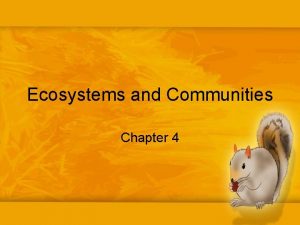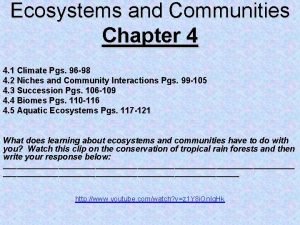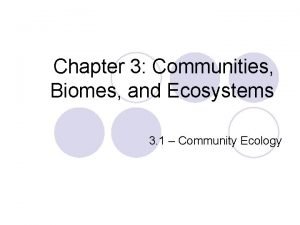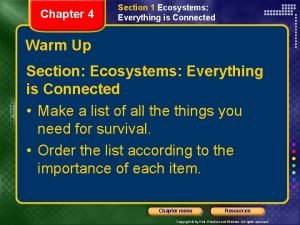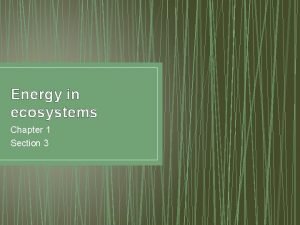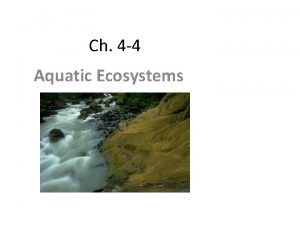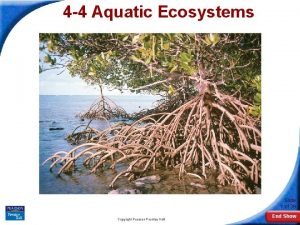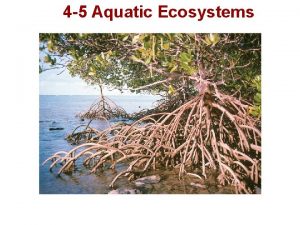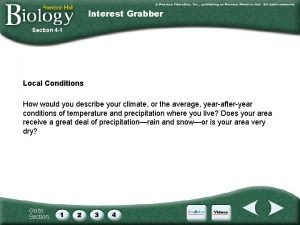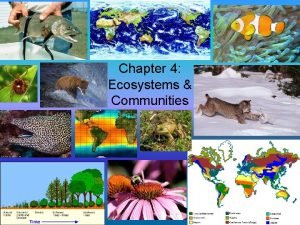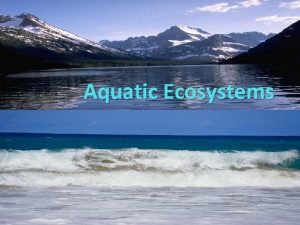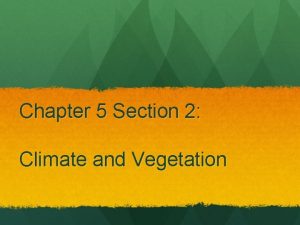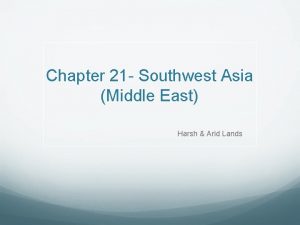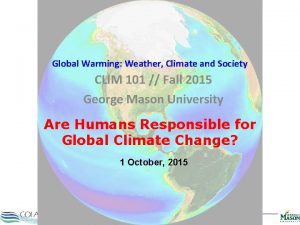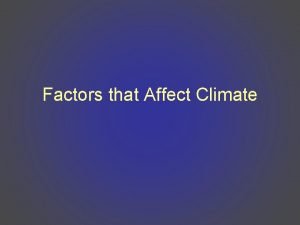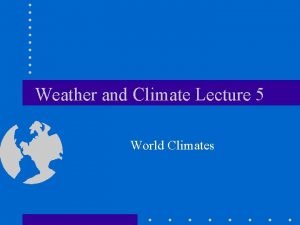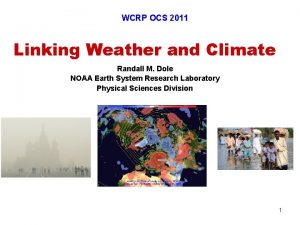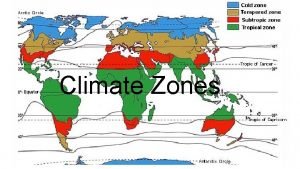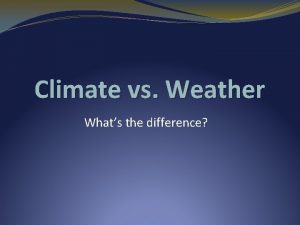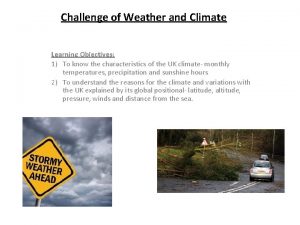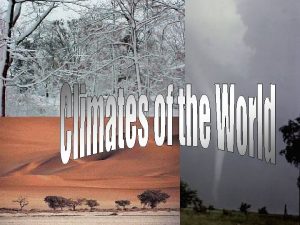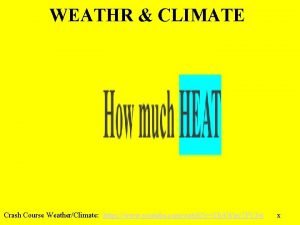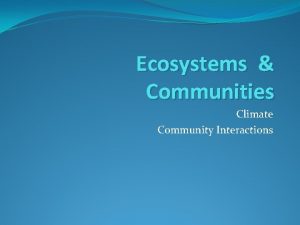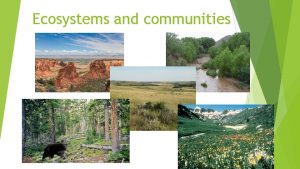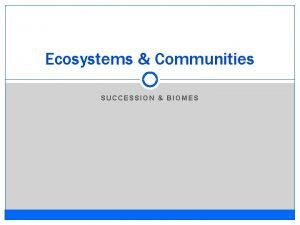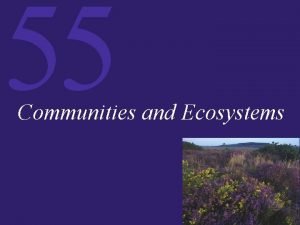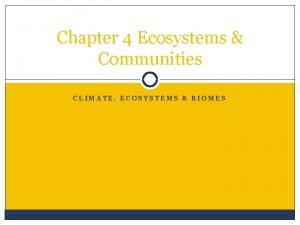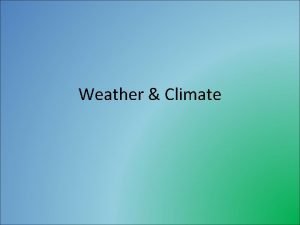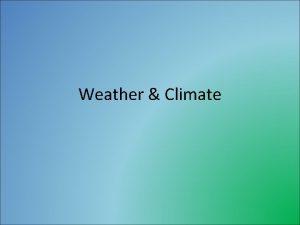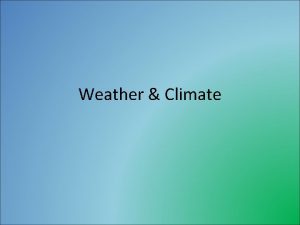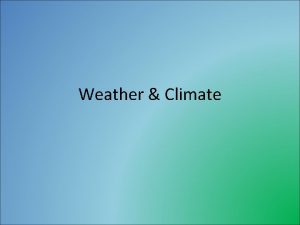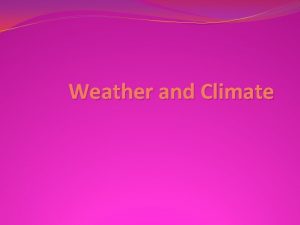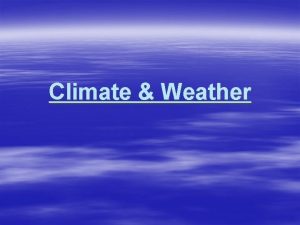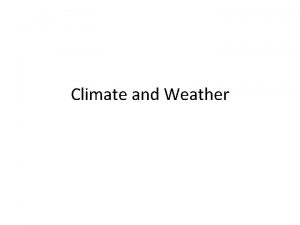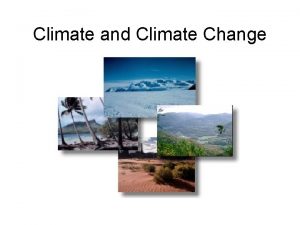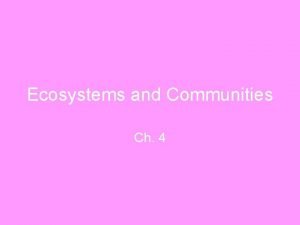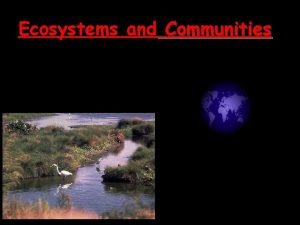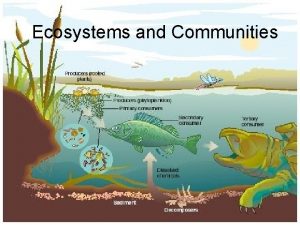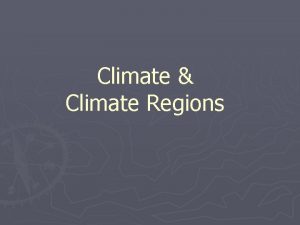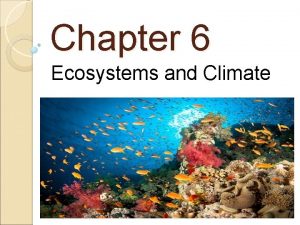Chapter 4 Ecosystems Communities Section 1 Climate Weather




























- Slides: 28

Chapter 4: Ecosystems & Communities Section 1: Climate

Weather & Climate • Weather: day to day conditions of Earth’s atmosphere • Climate: average conditions over long periods • A region’s climate is defined by year after year patterns of temperature and precipitation

Factors that Affect Climate • Global climate is shaped by many factors, including solar energy trapped in the biosphere, latitude, and the transport of heat by winds and ocean currents • Greenhouse Effect: Gasses called greenhouse gases, function like glass in a greenhouse, allowing visible light to enter but trapping heat • As the greenhouse gas concentrations rise they continue to trap heat, so the Earth warms • Wind and ocean currents which transports heat and moisture throughout the biosphere

Chapter 4: Ecosystems & Communities Section 2: Niches & Community Interactions

Niches • Population: All the members of one species that live in a particular area • Community: All of the different species that live in a particular area • Habitat: place where an organism lives; physical location of a community • Niche: what an organism dos and how it interacts with biotic and abiotic factors in the environment • The range of physical and biological conditions in which a species lives and the way the species obtains what it needs to survive and reproduce • Resource: any necessity of life, such as water, nutrients, light, food, or space

• Competition: when different species fight over resources; this interaction can be harmful or detrimental to both species • Examples: • When Mc. Donald’s and Burger King compete, they both lose money • Two animals fighting over a food source • Competition can have several outcomes: • One species wins & the other loses • The loser is eliminated from the habitat • Competitors can survive together in the same habitat bc they divide resources • Competition can lead to extinction: when all the members of a species die • Competitive Exclusion Principle: states that no two species can occupy exactly the same niche in exactly the same habitat at exactly the same time • By causing species to divide resources, competition helps determine the number and kinds of species in a community and he niche each species occupies

Predation, Herbivory, & Keystone Species • Predation: an interaction between 2 organisms in which one organism(the predator) kills & feeds on the other organism(the prey) • Predators can affect the size of prey populations in a community and determine the places prey can live and feed • Herbivory: an interaction in which one animal (the herbivore) feeds on producers (such as plants) • Herbivores can affect both the size and distribution of plant populations in a community and determine the places that certain plants can survive and grow • Keystone Species: single species that is not usually abundant in a community yet exerts strong control on the structure of a community

Symbioses • Symbiosis: a relationship in which 2 different organisms live in close association with each other • There are 2 types of symbiosis: • Mutualism: a relationship between 2 species in which both species benefit • example: a bee pollinates a flower and the flower provides nectar for the bee • Commensalism: a relationship between 2 organisms in which one organism benefits & the other is unaffected • example: a buffalo moves through the grass forcing insects to move which then get eaten by birds • the bird benefits but the buffalo is unaffected • Parasitism: a relationship between 2 species in which one species(the parasite) benefits from the other species(the host) which is harmed • examples: leeches, ticks, fleas, lice, mosquitoes, and tapeworms • the difference between predation and parasitism is that in predation one individual is killed immediately, while in parasitism the parasite feeds on the host for a long time

Chapter 4: Ecosystems & Communities Section 3: Succession

Primary & Secondary Succession • Ecological Succession: a series of more or less predictable changes that occur in a community over time • Ecosystems change over time, especially after disturbances, as some species die out and new species move in • Succession: the gradual re-growth of species in an area after some disturbance • disturbances such as fires, landslides, hurricanes, and floods change the species diversity in communities • Over the course of succession, the number of different species present typically increase

�Primary Succession: the development of a community in an area that has not supported life before ◦ such as bare rock, sand dunes, or an island formed by volcanic eruption ◦ often occurs very slowly

Primary Succession

• Secondary Succession: the development of species that follows the disruption of an area where life previously existed • such as after a forest fire, strong storm, farming, logging, or mining • the soil is left intact

Secondary Succession

Chapter 4: Ecosystems & Communities Section 4: Biomes

Biomes �Biome: large region characterized by a specific type of climate and certain types of plants and communities. ◦ Biomes are described in terms of abiotic factors like climate and soil type, and biotic factors like plant and animal life

Terrestrial Biomes • • • Tropical Rain Forest (Page 112) Tropical Dry Forest (Page 112) Tropical Grassland/Savanna/Shrubland (Page 112) Desert (Page 113) Temperate Grassland (Page 113) Temperate Woodland & Shrubland (Page 113) Temperate Forest (page 114) Northwestern Coniferous Forest (Page 114) Boreal Forest (Page 114) Tundra (Page 115)

Other Land Areas • Because they are not easily defined in terms of typical community of plants and animals, mountain ranges and polar ice caps are not usually classified into biomes • Mountain Ranges • exist on all continents and in many biomes • conditions vary with elevation • Polar Ice Caps • boarder the Tundra and are cold year round • plants are few but some algae grows on ice and snow • when rocks and ground are exposed mosses and lichens may grow seasonally • Typical animals include marine mammals, insects, and mites • in the North(Arctic Ocean) where there is sea ice polar bears are found • in the South(Antarctica) where the ice can be nearly 5 km thick many species of penguins are found

Chapter 4: Ecosystems & Communities Section 5: Aquatic Ecosystems

Conditions Underwater • Aquatic organisms are affected primarily by the water’s depth, temperature, flow, and amount of dissolved nutrients

Freshwater Ecosystems • Freshwater Zones • Rivers & Streams • bodies of water that flow downhill • the type of organisms usually depends on the speed of the water flow • slower water can generally support more diverse life

• Lakes & Ponds • rich in organic matter, making them murky • mud bottoms

• Lakes & Ponds • little organic matter, making them clear • sand or rocky bottoms

• Wetlands • Wetland: an ecosystem in which water either covers the soil or is present at or near the surface for at least part of the year • Water can either flow through a wetland or stay in place • Nutrient rich and highly productive • Types: • Freshwater Bogs • Freshwater Marshes • Freshwater Swamps • Saltwater Wetlands are called Estuaries

Saltwater Ecosystems • Estuaries • occur where freshwater rivers flow into the sea; mix of fresh water and salt water • includes bays, mud flats, salt marshes • rivers deposit mineral nutrients • most species can adapt to the rapidly changing conditions • Serve as spawning and nursery grounds for many ecologically important fish and shellfish species

�Marine Zones ◦ Intertidal Zone �alternates between submerged and exposed as tides shift �organisms must be able to withstand crashing waves �crabs, clams, oysters, sea anemones, sea stars ◦ Neritic Zone �most productive ocean zone �water is shallow enough for photosynthesis to occur �plankton, fish, squid, turtles, coral reefs, crustaceans

�Marine Zones ◦ Photic Zone �because of it’s immense size, over ½ of the world’s photosynthesis occurs here �fish, whales, squid ◦ Aphotic Zone �animals feed on sinking dead organisms and have slow metabolic rates �chemosynthetic bacteria can live near thermal vents

• Marine Zones
 Ecosystems and communities chapter 4 answer key
Ecosystems and communities chapter 4 answer key Parasitism examples
Parasitism examples Three biotic factors
Three biotic factors Hydrarch type of succession does not start on
Hydrarch type of succession does not start on Aquatic areas
Aquatic areas Section 1 ecosystems everything is connected
Section 1 ecosystems everything is connected World geography today
World geography today Climate change 2014 mitigation of climate change
Climate change 2014 mitigation of climate change Section 3 energy in ecosystems
Section 3 energy in ecosystems 4-4 aquatic ecosystems
4-4 aquatic ecosystems Section 4-4 aquatic ecosystems answer key
Section 4-4 aquatic ecosystems answer key 4-4 aquatic ecosystems
4-4 aquatic ecosystems Section 1 energy flow in ecosystems
Section 1 energy flow in ecosystems Interest grabber
Interest grabber Section 4-4 aquatic ecosystems
Section 4-4 aquatic ecosystems Section 1: freshwater ecosystems
Section 1: freshwater ecosystems Chapter 5 section 2 climate and vegetation answer key
Chapter 5 section 2 climate and vegetation answer key Why is the middle east so dry
Why is the middle east so dry Atmosphere
Atmosphere Clim 101
Clim 101 How do prevailing winds affect climate
How do prevailing winds affect climate Weather and climate similarities
Weather and climate similarities Conclusion of weather and climate
Conclusion of weather and climate Climate zones and weather worksheet answer key
Climate zones and weather worksheet answer key Whats the difference between weather and climate
Whats the difference between weather and climate Objectives of weather and climate
Objectives of weather and climate Climate vs weather
Climate vs weather Weathr for tomorrow
Weathr for tomorrow Weather and climate crash course
Weather and climate crash course
